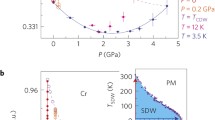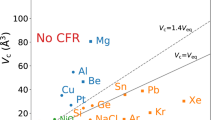Abstract
Some quantities relevant to mean-field models of charge-density wave (CDW) motion have been measured in NbSe3 between 144K and 60K. Data are presented on the threshold field ET, including the contribution from breaking (phase-slip) at the current terminals; on the increase of Frohlich current with field E, confirming the predicted variation as (E-ET)3/2 near threshold; and on the conduction due to transitions between metastable distorted states, and thus on the elastic modulus of the CDW. It is tentatively concluded that, at least between 60K and 90K, the conduction near threshold is restricted mainly by the need to maintain phase-slip at the boundaries of regions, perhaps pinned at surfaces, which do not join in the general motion. A new mean-field model, mathematically equivalent to those suggested by Fisher and by Sneddon, but related also to the phenomenological model of Tua and Zawadowski, is proposed to describe this.
Preview
Unable to display preview. Download preview PDF.
Similar content being viewed by others
References
H. Frohlich, Proc. Roy. Soc. A L22, 296 (1954).
see, e.g., the reviews by G. Gruner, Comments on Solid State Physics 10, 183 (1983), and N. P. Ong, Can. J. Phys. 60, 757 (1982).
J. Bardeen, Phys. Rev. Lett. 42, 1498 (1979), and 45, 1978 (1980).
S. G. Chung, Phys. Rev. B 29, 6977 (1984)
G. Grüner, A. Zawadoski and P. M. Chaikin, Phys. Rev. Lett. 46, 511 (1981).
J. Richard, P. Monceau and M. Renard, Phys. Rev. B 25, 948 (1982).
J. C. Gill, Solid State Commun. 39, 1203 (1981).
K. K. Fung and J. W. Steeds, Phys. Rev. Lett. 45, 1696 (1980).
T. Tamegai, K. Tsutsumi, S. Kagoshima, Y. Kanai, M. Tani, H. Tomozawa, M. Sato, K. Tsuji, J. Harada, M. Sakata and T. Nakajima, Solid State Commun. (in press).
N. P. Ong, G. Verma and K. Maki, Phys. Rev. Lett. 52, 663 (1984)
also J. C. Gill and A. W. Higgs, Solid State Commun. 48, 709 (1983).
L. Sneddon, M. C. Cross and D. S. Fisher, Phys. Rev. Lett. 49, 292 (1982).
H. Matsukawa and H. Takayama, Solid State Commun. (in press).
D. S. Fisher, Phys. Rev. Lett. 50, 1486 (1983).
L. Sneddon (preprint).
P. F. Tua and A. Zawadowski, Solid State Commun. 49, 19 (1984).
J. C. Gill, Solid State Commun. 44, 1041 (1982).
A. Zettl and G. Grüner, Phys. Rev. B 26, 2298 (1982); also R. P. Hall and A. Zettl, preprint.
J. C. Gill, Mol. Cryst. Liq. Cryst. 81, 791 (1982).
I. Batistić, A. Bjeliš and L. P. Gorkov (preprint) consider the case of current terminals covering the ends of the crystal, and predict that phase-slip will occur some distance inside it, giving a contribution to ET varying approximately as l −1.23. Whether the dependence in the present experiments, where contact was to one side of the crystal, is significantly different from this is uncertain, as there are indications that Vs is somewhat contact-dependent.
P. Monceau, M. Renard, J. Richard, M. C. Saint Lager, H. Salva and Z. Z. Wang, Phys. Rev. B 28, 1646 (1983), conclude that the frequency observed corresponds to passage through half-wavelengths. The values of Ic and νin figure 2 for E less than 1.5 ET give Ic/Sν ≈ 21 A cm−2MHz−1,, which appears to agree with that conclusion. However, it is evident that current then flows only through part of the cross-sectional area S, and that the true ratio of current density to ν is greater, possibly by a factor 2.
M. Oda and M. Ido, Solid State Commun. 44, 1535 (1982)
P. A. Lee and T. M. Rice, Phys. Rev. B 19, 3970 (1979)
J. C. Gill, Proceedings of the International Symposium on Nonlinear Transport and Related Phenomena in Inorganic Quasi One-Dimensional Conductors, Hokkaido University, 1983: p. 139. The concentration of distortion near the current terminals noted in this paper resulted from the use of pulses shorter than the characteristic time T, the large value of which in long specimens was not then appreciated.
J. C. Gill, J. Phys. F 10, L81 (1980).
Author information
Authors and Affiliations
Editor information
Rights and permissions
Copyright information
© 1985 Springer-Verlag
About this paper
Cite this paper
Gill, J.C. (1985). Distortion, metastability and breaking in charge-density wave transport: Recent experiments on niobium triselenide, suggesting a new mean-field approach. In: Hutiray, G., Sólyom, J. (eds) Charge Density Waves in Solids. Lecture Notes in Physics, vol 217. Springer, Berlin, Heidelberg. https://doi.org/10.1007/3-540-13913-3_237
Download citation
DOI: https://doi.org/10.1007/3-540-13913-3_237
Published:
Publisher Name: Springer, Berlin, Heidelberg
Print ISBN: 978-3-540-13913-3
Online ISBN: 978-3-540-39137-1
eBook Packages: Springer Book Archive




